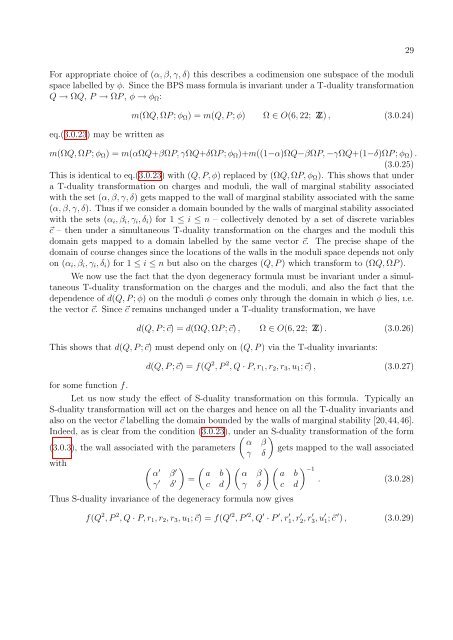PHYS08200604018 Shamik Banerjee - Homi Bhabha National ...
PHYS08200604018 Shamik Banerjee - Homi Bhabha National ...
PHYS08200604018 Shamik Banerjee - Homi Bhabha National ...
Create successful ePaper yourself
Turn your PDF publications into a flip-book with our unique Google optimized e-Paper software.
For appropriate choice of (α, β, γ, δ) this describes a codimension one subspace of the moduli<br />
space labelled by φ. Since the BPS mass formula is invariant under a T-duality transformation<br />
Q → ΩQ, P → ΩP , φ → φ Ω :<br />
eq.(3.0.23) may be written as<br />
m(ΩQ, ΩP ; φ Ω ) = m(Q, P ; φ) Ω ∈ O(6, 22; Z) , (3.0.24)<br />
m(ΩQ, ΩP ; φ Ω ) = m(αΩQ+βΩP, γΩQ+δΩP ; φ Ω )+m((1−α)ΩQ−βΩP, −γΩQ+(1−δ)ΩP ; φ Ω ) .<br />
(3.0.25)<br />
This is identical to eq.(3.0.23) with (Q, P, φ) replaced by (ΩQ, ΩP, φ Ω ). This shows that under<br />
a T-duality transformation on charges and moduli, the wall of marginal stability associated<br />
with the set (α, β, γ, δ) gets mapped to the wall of marginal stability associated with the same<br />
(α, β, γ, δ). Thus if we consider a domain bounded by the walls of marginal stability associated<br />
with the sets (α i , β i , γ i , δ i ) for 1 ≤ i ≤ n – collectively denoted by a set of discrete variables<br />
⃗c – then under a simultaneous T-duality transformation on the charges and the moduli this<br />
domain gets mapped to a domain labelled by the same vector ⃗c. The precise shape of the<br />
domain of course changes since the locations of the walls in the moduli space depends not only<br />
on (α i , β i , γ i , δ i ) for 1 ≤ i ≤ n but also on the charges (Q, P ) which transform to (ΩQ, ΩP ).<br />
We now use the fact that the dyon degeneracy formula must be invariant under a simultaneous<br />
T-duality transformation on the charges and the moduli, and also the fact that the<br />
dependence of d(Q, P ; φ) on the moduli φ comes only through the domain in which φ lies, ı.e.<br />
the vector ⃗c. Since ⃗c remains unchanged under a T-duality transformation, we have<br />
d(Q, P ;⃗c) = d(ΩQ, ΩP ;⃗c) , Ω ∈ O(6, 22; Z) . (3.0.26)<br />
This shows that d(Q, P ;⃗c) must depend only on (Q, P ) via the T-duality invariants:<br />
for some function f.<br />
d(Q, P ;⃗c) = f(Q 2 , P 2 , Q · P, r 1 , r 2 , r 3 , u 1 ;⃗c) , (3.0.27)<br />
Let us now study the effect of S-duality transformation on this formula. Typically an<br />
S-duality transformation will act on the charges and hence on all the T-duality invariants and<br />
also on the vector ⃗c labelling the domain bounded by the walls of marginal stability [20,44,46].<br />
Indeed, as is clear from the condition (3.0.23), under ( an)<br />
S-duality transformation of the form<br />
α β<br />
(3.0.3), the wall associated with the parameters gets mapped to the wall associated<br />
γ δ<br />
with ( ) ( ) ( ) ( )<br />
α<br />
′<br />
β ′<br />
−1<br />
a b α β a b<br />
γ ′ δ ′ =<br />
. (3.0.28)<br />
c d γ δ c d<br />
Thus S-duality invariance of the degeneracy formula now gives<br />
f(Q 2 , P 2 , Q · P, r 1 , r 2 , r 3 , u 1 ;⃗c) = f(Q ′2 , P ′2 , Q ′ · P ′ , r ′ 1, r ′ 2, r ′ 3, u ′ 1;⃗c ′ ) , (3.0.29)<br />
29

















